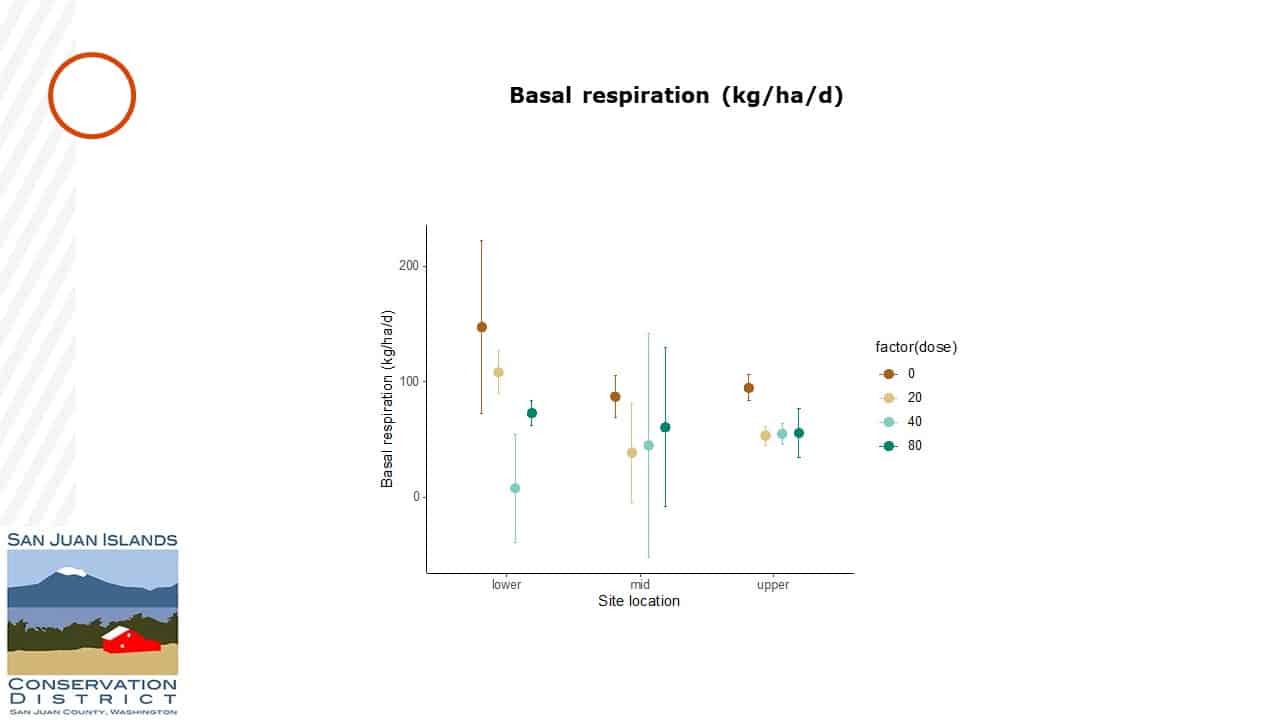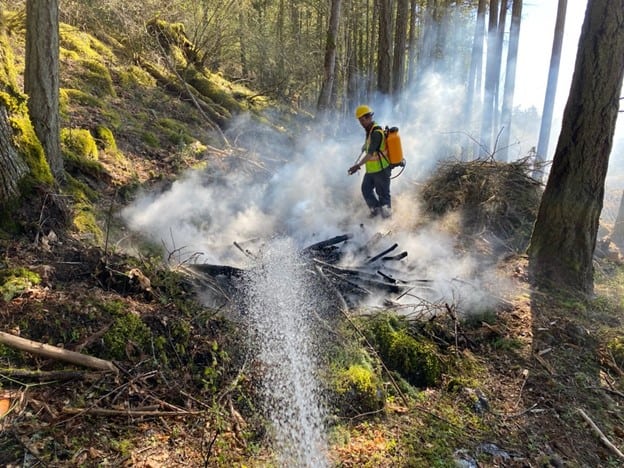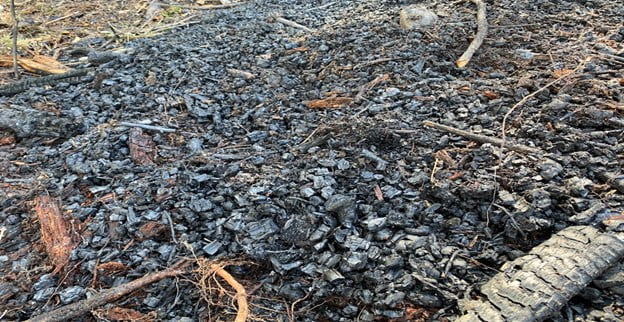Editors’ Note: Kai Hoffman-Krull is the Forest Health Manager for the San Juan Islands Conservation District in Washington state. The San Juan Islands Conservation District was founded in 1947 and helps landowners conserve natural resources by providing free consultation services, project “cost share” funding and detailed technical assistance around conservation activities from the Natural Resource Conservation Service. In this research focused blog Kai shares the results of a fascinating project the Conservation District recently completed together with the University of Oregon focused on producing biochar from controlled burns and how the use of biochar on the soil can result in healthier, more drought resistant forests, as well as address the carbon off-gassing which is often a result of prescribed burns and wildfires. The findings from this research help grow the understanding of how to build forest resiliency in the face of a changing climate and increased wildfire activity.
The presence of wildfires filled the air of the West Coast this past year, haze turning the color of the sun from orange to flame red. We know that smoke will return. Research indicates forest fires are expected to increase in a changing climate by weakening tree stands through extreme and unpredictable weather patterns.[1] This rise in fire has the potential to enhance the momentum of our changing climate by increasing carbon off-gassing into the atmosphere and simultaneously decreasing the ability of our forests to store carbon. Our forests are at risk in a time when we need them to be a part of climate solutions. The answer to this problem may rest in how we understand the ecology of the past and transition current waste into the fertility of the future.
Forests as a Tool for Fighting Climate Change
Forests serve as one of the world’s largest carbon sinks, absorbing an estimated 2.4 billion tons of carbon dioxide each year, about a third of the carbon dioxide released globally by burning fossil fuels.[2] The good news is they can do even more. An analysis from the Nature Conservancy predicts that investing in forest health through restoration and decreasing deforestation could remove 7 billion metric tons of carbon dioxide annually.[3] That is the equivalent of taking 1.5 billion cars off the road, which is more than all of the cars in the world today.
The solution can also be the problem. Wildfires release the carbon stored in trees and soil, accounting for between 5-10 percent of annual carbon dioxide emissions each year around the world.[4] In areas with significant wildfire activity, the rates can be even higher. The fires in California last year generated an estimated 90 million metric tons of carbon dioxide, 30 million tons more than the total carbon dioxide emissions from providing power to the entire state.[5] As climate change brings dry summers and long droughts, the rate of wildfires will likely expand, and with it rising amounts of carbon off-gassing.[6] This could result in a feedback loop where forests contribute increasing amounts of carbon into the atmosphere, furthering the changes causing the increase in fires.
Historical Fires
While the forest fires of today are contributing to our atmospheric carbon crisis, modern day fires do not look like the fires of the past. Fire has served as a central element of old growth forest ecosystems in the Pacific Northwest.[7] Flames would consume the smaller trees and brush that had not developed fire retardant in the bark, with the larger trees remaining alive. The small trees would often smolder in the understory, leaving behind charcoal in the soil and in the bark of the larger trees.
The Salish people of the Puget Sound also used fire to cultivate native foods. The first European settlers thought the forests of the Pacific Northwest were forests naturally abundant with food crops, when really they were actually gardens.[8] The Salish people used fire to drive deer and elk into central locations where they could be more easily hunted, and burned their most common root and berry crops after harvest. Controlled burns served to replicate the role of wildfires in old growth systems, thinning and cleaning the forest floor while providing ash and charcoal to fertilize the next generation of plants.[9]
Fire stopped playing a significant role in forest ecology after the Great Fire of 1910. The burn covered over 3 million acres in Montana, Idaho and Washington in two days. Directly after the incident the US Forest Service developed a policy of fire suppression, where fires were immediately fought upon sighting. [10] While this policy was seen as saving salable timber from being unnecessarily consumed, it also eradicated a central piece of forest ecosystems that thinned smaller, sickly trees and provided soil amendments for future tree stands.
Replicating Fire
Manual thinning of forests has become the common technique to reduce the fuel load in modern forests and reduce catastrophic fires. Like weeding a garden, taking out the low vigor trees provides more nutrients, light and water to the trees that remain. “The need for forest restoration is being driven largely by the need to lower the risk of high-intensity wildfires and restore forest health,” said University of California Merced scientist Roger Bales.[11] The US Forest Service estimates that 66 million acres require forest restoration thinning in the United States.[12]

A fuel reduction project on Waldron Island in San Juan County. Credit: Forage
The material cut out of our forests is commonly burned in piles that turns the wood into ash and releases almost all of the stored carbon into the air, while also creating habitat for invasive weeds. A significant body of research indicates, however, that if this material was turned into charcoal, it would replicate and enhance part of the forest’s natural nutrient cycling system . Also known as “biochar,” charcoal has been shown to store around 50% of the carbon in the woody material in a stable form that can last for hundreds to thousands of years.[1]
Biochar Research with Oregon State University
The San Juan Islands Conservation District partnered with Oregon State University to conduct an in-forest biochar research project in the San Juan Islands from 2020-2021. The research design set up plots in three different forest sites to examine influence of biochar additions at different applications rates in a top slope, mid slope and bottom slope environment. The research project looked at additions of 20 tons per hectare, 40 tons per hectare, 80 tons per hectare and no biochar addition (control), with biochar incorporated to a depth of 30 cm. Each treatment was replicated 4 times at each site.

These are images of the test plots at the lower, mid, and upper sites. The boxes illustrate the application rate applied for both plots with Douglas Fir and Red Alder, each replicated 4 times at each site. Photo credits: San Juan Islands Conservation District.
The first major finding was that the increased carbon levels directly correlated to the amounts of biochar added. It is important to note that the upper site with the sandiest soil illustrated the largest increases of carbon:

The graph represents carbon levels at different application rates averaged between all three test plot sites. Photo credit: San Juan Islands Conservation District and Oregon State University.
Another key finding was that carbon off-gassing levels, termed “basal respiration,” was also reduced with biochar addition. This reduction in respiration means that the stabilized, or recalcitrant carbon, is capturing and stabilizing the bioactive carbon that can be utilized by the forest microbiome. So that means there’s less carbon getting put into the atmosphere.

This graph illustrates the rate of respiration of carbon from the soil after biochar application of different rates at the three different test plot sites. Photo credit: San Juan Islands Conservation District and Oregon State University.
Lastly, the study illustrated that after 8 months of biochar addition, the water holding capacity of the soil increased with direct correlation to the amount of biochar added between all sites, with the 80 tons/ hectare rate more than doubling the water holding capacity of the control. More water being held in the soil means more resilience to drought conditions. This is a vital finding seeing as San Juan County is projected by the Washington Department of Natural Resources to have the highest increase in drought conditions of any populated area in Western Washington over the next 20 years.[14] As charcoal holds a residence time in the soil between several hundred years to a few millennia, these benefits could improve forest health for generations.[15]

Graphs capture water holding capacity and bulk density increases at the 4 different application rates. Photo credit: San Juan Islands Conservation District and Oregon State University.
Conservation Corps putting Research into Action
In 2020 the San Juan Islands Conservation District launched the Islands Conservation Corps (ICC) to address a series of ecological challenges in the County, with forest restoration as a key objective. The ICC collaborated with a forestry company, Rainshadow Consulting, and the local energy company, OPALCO, to conduct fuel reduction treatments along utility rights-of-ways on major roads on Orcas Island and Shaw Island. The goals of the project were to reduce the severity of fire along power-lines to preserve infrastructure, increase safety along major roadways for evacuation during a fire event and to produce biochar from the forest residue to improve forest health.
Burn piles of similar size material (within 2 inches) and species type were arranged 100 feet away from the power lines in January of 2021 and then lit the first week of April, 2021.

A Conservation Burn along Orcas Road. Photo credit: San Juan Islands Conservation District.
The crew used a 1,200 gallon water truck to extinguish the piles after 20-30 minutes of burning to extinguish the fire at the point with maximum coals, a technique termed Conservation Burns.

Conservation Burn being extinguished by CCC members. Photo Credit: San Juan Islands Conservation District.
After extinguishing, the piles were raked and monitored through the evenings to make sure re-ignition did not occur. Each pile resulted in a high concentration of biochar that will be spread around the remaining trees and used to plant native shrub pollinators in the fall.

Example of the biochar produced after the Conservation Burn is extinguished. Photo credit: San Juan Islands Conservation District.
Barb Pesola, one of the landowners on Orcas Island who gives OPALCO an easement on her land for use of the power lines, appreciated learning about the role of fire in forest health, “I knew nothing about forestry conservation, but these young people on the ICC crew have taught me quite a lot about bringing it back to its natural state and it looks just beautiful. I’m grateful to get all that woody mass out of there. Historically natural fire cycles would’ve taken care of this – but that hasn’t happened in a long time so this is a controlled way of bringing fire back to the landscape.”
Working with the Carbon Cycle
The ICC, piloting biochar production from fuel reduction treatments, is an example of how any burn pile can become a biochar burn. As nonprofits and agencies throughout the country look for ways to process the biomass from fuel reduction projects, biochar provides an opportunity to return the carbon of our forests back to the soil. Finding ways to understand and work within the carbon cycle of our forests and return them to old growth spacing through thinning will be central to our fire risk for years to come and will serve to foster their resiliency into the future.
_______________________________________________________
[1] https://www.ncbi.nlm.nih.gov/pmc/articles/PMC4874420/
[2] https://www.yaleclimateconnections.org/2016/05/the-climate-benefits-of-healthy-forests/
[3] https://www.wri.org/blog/2017/11/conserving-forests-could-cut-carbon-emissions-much-getting-rid-every-car-earth
[4] https://insideclimatenews.org/news/23082018/extreme-wildfires-climate-change-global-warming-air-pollution-fire-management-black-carbon-co2
[5] https://www.washingtonpost.com/politics/2020/09/17/energy-202-california-fires-are-putting-huge-amount-carbon-dioxide-into-air/
[6] https://insideclimatenews.org/news/23082018/extreme-wildfires-climate-change-global-warming-air-pollution-fire-management-black-carbon-co2
[7] https://www.fs.fed.us/pnw/pubs/science-update-4.pdf
[8] http://osupress.oregonstate.edu/book/indians-fire-and-land-in-pacific-northwest/intro
[9] George Vancouver, A Voyage of Discovery to the North Pacific Ocean and Round the World, 1791-1795, vol. II. W, Kaye Lamb ed. (London, 1984), 568.
[10] https://foresthistory.org/research-explore/us-forest-service-history/policy-and-law/fire-u-s-forest-service/u-s-forest-service-fire-suppression/
[11] https://www.sciencedaily.com/releases/2018/04/180424160251.htm
[12] https://www.sciencedaily.com/releases/2018/04/180424160251.htm
[13] http://www.css.cornell.edu/faculty/lehmann/publ/FrontiersEcolEnv%205,%20381-387,%202007%20Lehmann.pdf
[14] https://www.dnr.wa.gov/ForestActionPlan
[15] https://onlinelibrary.wiley.com/doi/abs/10.1002/jpln.201400058
* * * *


Very interesting project and compelling results. How was the biochar incorporated into the soil? Also, you mention invasive establishment following pile burning, did this differ using the biochar process described?
As the piles were burned this spring, we are waiting to plant the areas this fall with bare root plantings and wildflower seed. The biochar will be incorporated into the planting holes and raked into the first several inches of topsoil. The moisture absorption during the winter, mixed with freezing, will slowly break the charcoal up and incorporate it into subsoil layers over the next several years.
Awesome story, congratulations to all! Biochar is so amazing and so ignored by forest managers and commercial crop growers, such as wheat in E. Washington. A lot of projects seemed to be on the move a decade or so ago in Washington then pretty much dwindled away for a multitude of reasons, some known and some unknown. Such great news! Thanks for the write up and post.
What vegetation have you seen return to the area, pre burn and after the bio-char burn.
The salal has been coming back nicely, and some native forbs have germinated. We are going to be planting the areas this fall.
This is great, Kai! Thanks for sharing. I’m wondering how many tons of biochar you can get out of one “conservation burn” pile?
Dear Kai, it is a very interesting study and we need more such studies in different parts of the world. I would like to know if 1200 gallon water was used to extinguish 1 pile or all the piles, and how much biochar was produced from 1 pile? This will help understand if the rise in water holding capacity is comparable in a state like California. Also, 82.7% carbon in biochar – was it fixed carbon or total carbon? Thank you. Best, Sonal
Hi,
This is terrific work. I think you should incorporate an evolved equipment fleet of small excavators with tree shears and brush rakes to clear larger areas which you can then burn in windrows to create biochar “zones”.
This will expand the concept to a commercial level which would appeal to people who have the equipment and can then offer it as a service.
We face a problem of scale with this and hand labor, however noble just does not cut it.
Thank you very much for your valuable work.